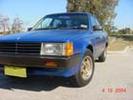| Author | Topic |
|---|

Location:
Perth
Registered:
August 2003
|
|
Question: First turbo car built.. by who and when?
|
 Fri, 09 January 2004 21:04
Fri, 09 January 2004 21:04

|
 |
just wondering when was the first turbo car made and by who?
|
|
|

Location:
Northwestern Sydney
Registered:
August 2002
|
|
Re: Question: First turbo car built.. by who and when?
|
 Fri, 09 January 2004 23:11
Fri, 09 January 2004 23:11
 
|
 |
The first exhaust-driven supercharger was developed by Dr. Alfred J. Buchi of Switzerland between 1909 and 1912, long before Garrett products entered the turbocharger picture. Dr. Buchi was Chief Engineer of Sulzer Brothers Research Department and in 1915 proposed the first prototype of a turbocharged diesel engine, but his ideas gained little or no acceptance at that time.
General Electric began developing turbochargers during the late 1910's. In 1920, a LePere bi-plane that was equipped with a Liberty engine and a General Electric turbocharger set a new altitude record of 33,113 feet (10092m).
Turbochargers were used sparingly on aircraft in World War I, but their development occurred on a widening scale in the 1930's and 1940's - first in Europe and then in the United States. In the United States, General Electric developed turbochargers for military aircraft, and in World War II, thousands were used on fighter aircraft and bombers, such as the B-17. The Garrett Corporation, formed in 1936 by J. C. "Cliff" Garrett, supplied the charge air cooler (aftercooler) for the B-17, located between the General Electric turbocharger and the Pratt and Whitney engine.
In the late 1940's and early 1950's, Garrett was heavily committed to the design of small gas turbine engines from 20 - 90 horse power (15 - 67 kw). The engineers had developed a good background in the metallurgy of housings, high speed seals, radial inflow turbines, and centrifugal compressors.
On September 27, 1954, Cliff Garrett made the decision to separate the turbocharger group from the Gas Turbine department due to commercial diesel turbocharger opportunities. That was the beginning of the new AiResearch Industrial Division - for turbocharger design and manufacturing. AiResearch Industrial Division would later be named Garrett Automotive.
The Chevrolet Corvair Monza and the Oldsmobile Jetfire were the first turbo-powered passenger cars, and made their debut on the US market in 1962/63. Despite maximum technical outlay, however, their poor reliability caused them to disappear quickly from the market.
The internal combustion engine is an air consuming machine. This is because the fuel that is burned requires air with which it can mix to complete the combustion cycle. Once the air/fuel ratio reaches a certain point, the addition of more fuel will not produce more power, but only black smoke or unburned fuel into the atmosphere. The more dense the smoke, the more the engine is being over fueled. Therefore, increasing the fuel delivery beyond the air/fuel ratio limit results in excessive fuel consumption, pollution, high exhaust temperature (diesel) or low exhaust temperature (gasoline), and shortened engine life.
After the first oil crisis in 1973, turbocharging became more acceptable in commercial diesel applications. Until then, the high investment costs of turbocharging were offset only by fuel cost savings, which were minimal. Increasingly stringent emission regulations in the late 80's resulted in an increase in the number of turbocharged truck engines, so that today, virtually every truck engine is turbocharged.
In the 70's, with the turbocharger's entry into motor sports, especially into Formula I racing, the turbocharged passenger car engine became very popular. The word "turbo" became quite fashionable. At that time, almost every automobile manufacturer offered at least one top model equipped with a turbocharged petrol engine. However, this phenomenon disappeared after a few years because although the turbocharged petrol engine was more powerful, it was not economical. Furthermore, the "turbo-lag", the delayed response of the turbochargers, was at that time still relatively large and not accepted by most customers.
The real breakthrough in passenger car turbocharging was achieved in 1978 with the introduction of the first turbocharged diesel engine passenger car in the Mercedes-Benz 300 SD, followed by the VW Golf Turbodiesel in 1981. By means of the turbocharger, the diesel engine passenger car's efficiency could be increased, with almost petrol engine "driveability", and the emissions significantly reduced.
Today, the turbocharging of petrol engines is no longer primarily seen from the performance perspective, but is rather viewed as a means of reducing fuel consumption and, consequently, environmental pollution on account of lower carbon dioxide (CO2) emissions. Currently, the primary reason for turbocharging is the use of the exhaust gas energy to reduce fuel consumption and emissions.
|
|
|

Location:
Perth
Registered:
August 2003
|
|
Re: Question: First turbo car built.. by who and when?
|
 Sat, 10 January 2004 15:51
Sat, 10 January 2004 15:51
 
|
 |
thats for the story i thought someone was gonna give me a one liner 
|
|
|
Registered:
March 2003
|
|
Re: Question: First turbo car built.. by who and when?
|
 Sun, 11 January 2004 07:08
Sun, 11 January 2004 07:08

|
 |
| Lambolica wrote on Sat, 10 January 2004 10:11 |
Today, the turbocharging of petrol engines is no longer primarily seen from the performance perspective, but is rather viewed as a means of reducing fuel consumption and, consequently, environmental pollution on account of lower carbon dioxide (CO2) emissions.
|
hrmmm.. i wonder how many people on this board bought a turbocharged car or installed a turbo and did it to lower fuel consumption, and not thinking mostly about performance.
and then got a horrible shock

|
|
|
| Current Time:
Wed Nov 12 23:58:38 UTC 2025 |
Total time taken to generate the page: 0.0028629302978516 seconds |